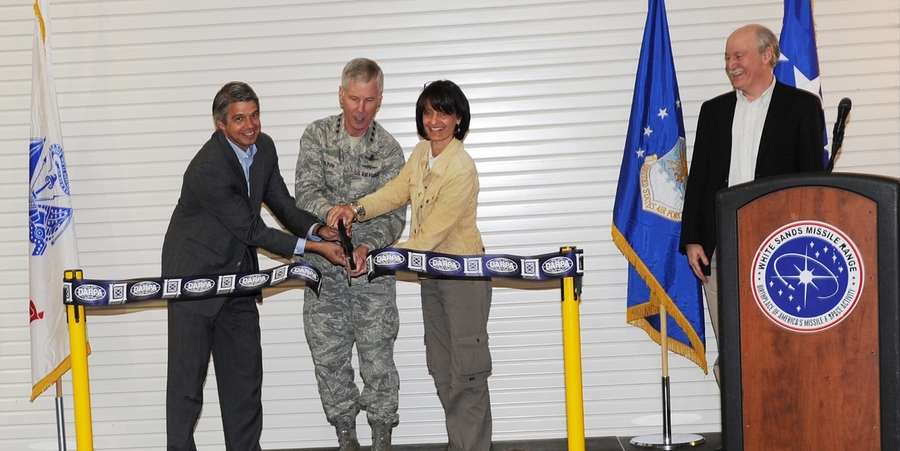On Oct. 12, 2011, the completion of construction of the Defense Advanced Research Projects Agency’s Space Surveillance Telescope (SST) was celebrated with a ribbon-cutting ceremony at the SST’s location on the White Sands Missile Range in New Mexico. MIT Lincoln Laboratory has been responsible for the development of critical technologies for the SST as well as integration of the entire SST system.
Prior to the ribbon-cutting ceremony, on Feb. 15, 2011, the SST achieved first light — the first successful image capture by a telescope — and to the gratification of the researchers involved in the nine-year development, acquisition of an astronomical image was accomplished on the first try — a feat almost unheard of for optical systems of the SST’s scale.
The SST, developed under sponsorship of the Defense Advanced Research Projects Agency (DARPA), is a ground-based electro-optical space surveillance system whose innovative design allows rapid, wide-area scanning of the sky and provides enhanced sensitivity for detecting faint objects in deep space. The unique curved charge-coupled device technology integrated into a very large pixel count camera and the high-speed shutter, both developed at Lincoln Laboratory, enable the SST’s exceptional capabilities. “SST is the first comprehensive technology push for the nation in deep-space optical tracking since GEODSS [the Ground-based Electro-optical Deep Space Surveillance system at White Sands] in the 1980s—this will be a game changer,” says Dr. Eric Pearce, associate leader of the Space Control Systems Group and manager responsible for the Laboratory’s SST program.
The SST can be used to expand the catalog of objects in the geosynchronous region and other high-interest areas of space, via wide-area search operations; providing scientists with a more complete picture of potential hazards to satellites. In addition, the SST may be used to accomplish astronomical surveys of stars, comets, and minor planets.
Following the DARPA demonstration period, the SST will be transferred for operational evaluation and for use as a contributing sensor to the Space Surveillance Network.
Prior to the ribbon-cutting ceremony, on Feb. 15, 2011, the SST achieved first light — the first successful image capture by a telescope — and to the gratification of the researchers involved in the nine-year development, acquisition of an astronomical image was accomplished on the first try — a feat almost unheard of for optical systems of the SST’s scale.
The SST, developed under sponsorship of the Defense Advanced Research Projects Agency (DARPA), is a ground-based electro-optical space surveillance system whose innovative design allows rapid, wide-area scanning of the sky and provides enhanced sensitivity for detecting faint objects in deep space. The unique curved charge-coupled device technology integrated into a very large pixel count camera and the high-speed shutter, both developed at Lincoln Laboratory, enable the SST’s exceptional capabilities. “SST is the first comprehensive technology push for the nation in deep-space optical tracking since GEODSS [the Ground-based Electro-optical Deep Space Surveillance system at White Sands] in the 1980s—this will be a game changer,” says Dr. Eric Pearce, associate leader of the Space Control Systems Group and manager responsible for the Laboratory’s SST program.
The SST can be used to expand the catalog of objects in the geosynchronous region and other high-interest areas of space, via wide-area search operations; providing scientists with a more complete picture of potential hazards to satellites. In addition, the SST may be used to accomplish astronomical surveys of stars, comets, and minor planets.
Following the DARPA demonstration period, the SST will be transferred for operational evaluation and for use as a contributing sensor to the Space Surveillance Network.






